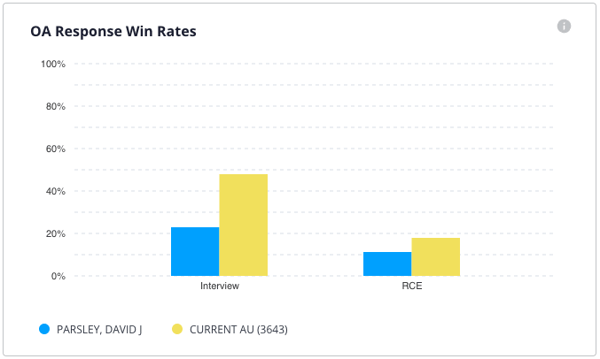How does using data in patent prosecutions generate more revenue and better prosecution outcomes? Patent analytics can be a game changer for your strategy, but you’ve got to know how to use them.
To fully leverage prosecution data, you have to think about it in terms of the value it provides your organization. Here are some of the ways that using data in your prosecution practice can have a real impact on the outcomes for your client or your organization's bottom line.
How Data Helps in Patent Prosecutions
Missed Appeals
Often clients are reluctant to appeal an office action because appeals are generally expensive and time-intensive. However, an appeal might be the best option to get to a positive result for your client.
For instance, examiner David Parlsey, shown in the example below, has only 23% and 11% win rates after interviews and RCEs, respectively.

However, the Parsley has been reversed 48 times, or about 57% of the time, by the PTAB (plus, he’s been reversed in part 14 times, or 17%).
Given those metrics, it might seem obvious that an appeal provides the best chance of success, but without data to support that recommendation, a client may balk at the added time and expense.
Early Abandonment
Juristat considers applications that are "abandoned early" are the applications abandoned after two office actions and are in front of examiners who are more likely to allow applications after the third office action.
An example of such an examiner is below. In this graph, taken from an examiner report, we see the breakdown of allowed vs. abandoned applications at a given number of office actions. More simply, of the applications disposed (allowed/abandoned) after a given number of office actions, what percentage were allowed?
In this example, Parsley's percentage of allowed applications (shown in green) is still significant after the third office action and later, meaning there is still a likely chance of allowance. Thus, while an assignee might be apt to abandon an application after two office actions, the data can help support a recommendation to proceed, as there is a strong chance of success.
Missed CON/CIP
There are also opportunities to add a little extra claim scope to an application by filing a continuation or continuation-in-part. Juristat considers a "missed" continuation or CIP opportunity is an application in front of an examiner with a 90% or higher allowance rate where no continuation or CIP was filed.
Such instances create the opportunity to suggest a continuation or CIP to a client with a high probability that the continuation/CIP will be successful.
Adding It Up
All of these individual opportunities can add up to both improved outcomes for clients and an increased bottom line for a firm. For instance, the table below shows how capitalizing on these opportunities can make a real impact on a law firm's business.
.png?width=600&height=300&name=Missed%20Revenue%20Opportunity%20(1).png)
(Approximate fees are based on AIPLA's 2023 Report of the Economic Survey)
Keeping the value of the application in mind is necessary to make the best prosecution decisions. Taking advantage of data like this presents your IP team with the opportunity to increase your profit and enhance your strategic position. Is your team ready to take your patent prosecution to the next level? Schedule a demo today.
(gradient).webp)

